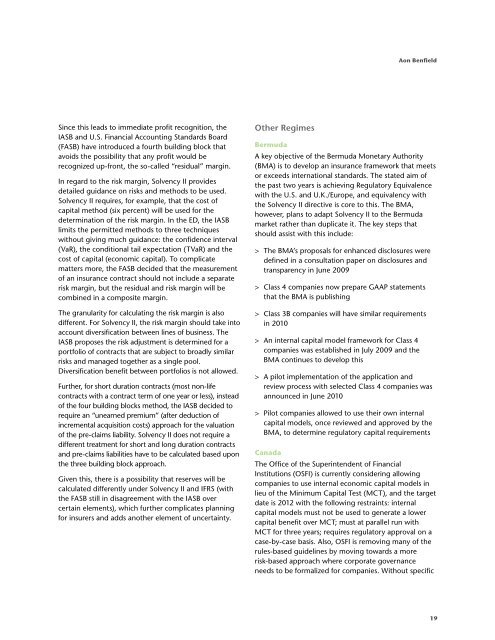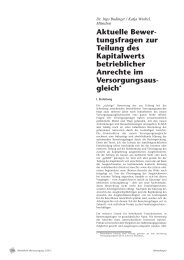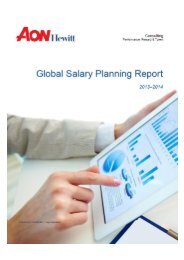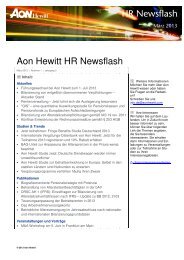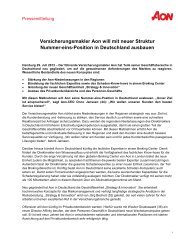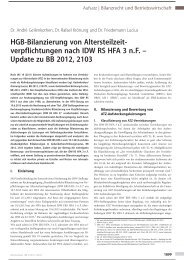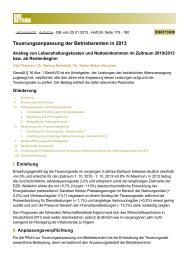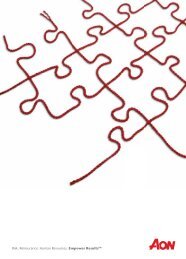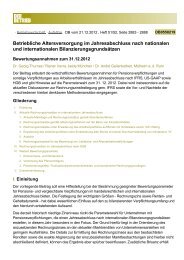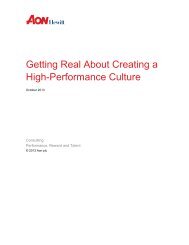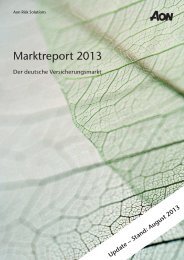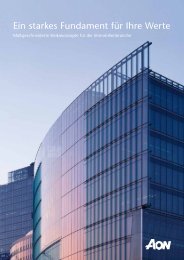Evolving Criteria - Reinsurance Thought Leadership | Aon Benfield
Evolving Criteria - Reinsurance Thought Leadership | Aon Benfield
Evolving Criteria - Reinsurance Thought Leadership | Aon Benfield
Create successful ePaper yourself
Turn your PDF publications into a flip-book with our unique Google optimized e-Paper software.
Since this leads to immediate profit recognition, the<br />
IASB and U.S. Financial Accounting Standards Board<br />
(FASB) have introduced a fourth building block that<br />
avoids the possibility that any profit would be<br />
recognized up-front, the so-called “residual” margin.<br />
In regard to the risk margin, Solvency II provides<br />
detailed guidance on risks and methods to be used.<br />
Solvency II requires, for example, that the cost of<br />
capital method (six percent) will be used for the<br />
determination of the risk margin. In the ED, the IASB<br />
limits the permitted methods to three techniques<br />
without giving much guidance: the confidence interval<br />
(VaR), the conditional tail expectation (TVaR) and the<br />
cost of capital (economic capital). To complicate<br />
matters more, the FASB decided that the measurement<br />
of an insurance contract should not include a separate<br />
risk margin, but the residual and risk margin will be<br />
combined in a composite margin.<br />
The granularity for calculating the risk margin is also<br />
different. For Solvency II, the risk margin should take into<br />
account diversification between lines of business. The<br />
IASB proposes the risk adjustment is determined for a<br />
portfolio of contracts that are subject to broadly similar<br />
risks and managed together as a single pool.<br />
Diversification benefit between portfolios is not allowed.<br />
Further, for short duration contracts (most non-life<br />
contracts with a contract term of one year or less), instead<br />
of the four building blocks method, the IASB decided to<br />
require an “unearned premium” (after deduction of<br />
incremental acquisition costs) approach for the valuation<br />
of the pre-claims liability. Solvency II does not require a<br />
different treatment for short and long duration contracts<br />
and pre-claims liabilities have to be calculated based upon<br />
the three building block approach.<br />
Given this, there is a possibility that reserves will be<br />
calculated differently under Solvency II and IFRS (with<br />
the FASB still in disagreement with the IASB over<br />
certain elements), which further complicates planning<br />
for insurers and adds another element of uncertainty.<br />
Other Regimes<br />
<strong>Aon</strong> <strong>Benfield</strong><br />
Bermuda<br />
A key objective of the Bermuda Monetary Authority<br />
(BMA) is to develop an insurance framework that meets<br />
or exceeds international standards. The stated aim of<br />
the past two years is achieving Regulatory Equivalence<br />
with the U.S. and U.K./Europe, and equivalency with<br />
the Solvency II directive is core to this. The BMA,<br />
however, plans to adapt Solvency II to the Bermuda<br />
market rather than duplicate it. The key steps that<br />
should assist with this include:<br />
> The BMA’s proposals for enhanced disclosures were<br />
defined in a consultation paper on disclosures and<br />
transparency in June 2009<br />
> Class 4 companies now prepare GAAP statements<br />
that the BMA is publishing<br />
> Class 3B companies will have similar requirements<br />
in 2010<br />
> An internal capital model framework for Class 4<br />
companies was established in July 2009 and the<br />
BMA continues to develop this<br />
> A pilot implementation of the application and<br />
review process with selected Class 4 companies was<br />
announced in June 2010<br />
> Pilot companies allowed to use their own internal<br />
capital models, once reviewed and approved by the<br />
BMA, to determine regulatory capital requirements<br />
Canada<br />
The Office of the Superintendent of Financial<br />
Institutions (OSFI) is currently considering allowing<br />
companies to use internal economic capital models in<br />
lieu of the Minimum Capital Test (MCT), and the target<br />
date is 2012 with the following restraints: internal<br />
capital models must not be used to generate a lower<br />
capital benefit over MCT; must at parallel run with<br />
MCT for three years; requires regulatory approval on a<br />
case-by-case basis. Also, OSFI is removing many of the<br />
rules-based guidelines by moving towards a more<br />
risk-based approach where corporate governance<br />
needs to be formalized for companies. Without specific<br />
19


